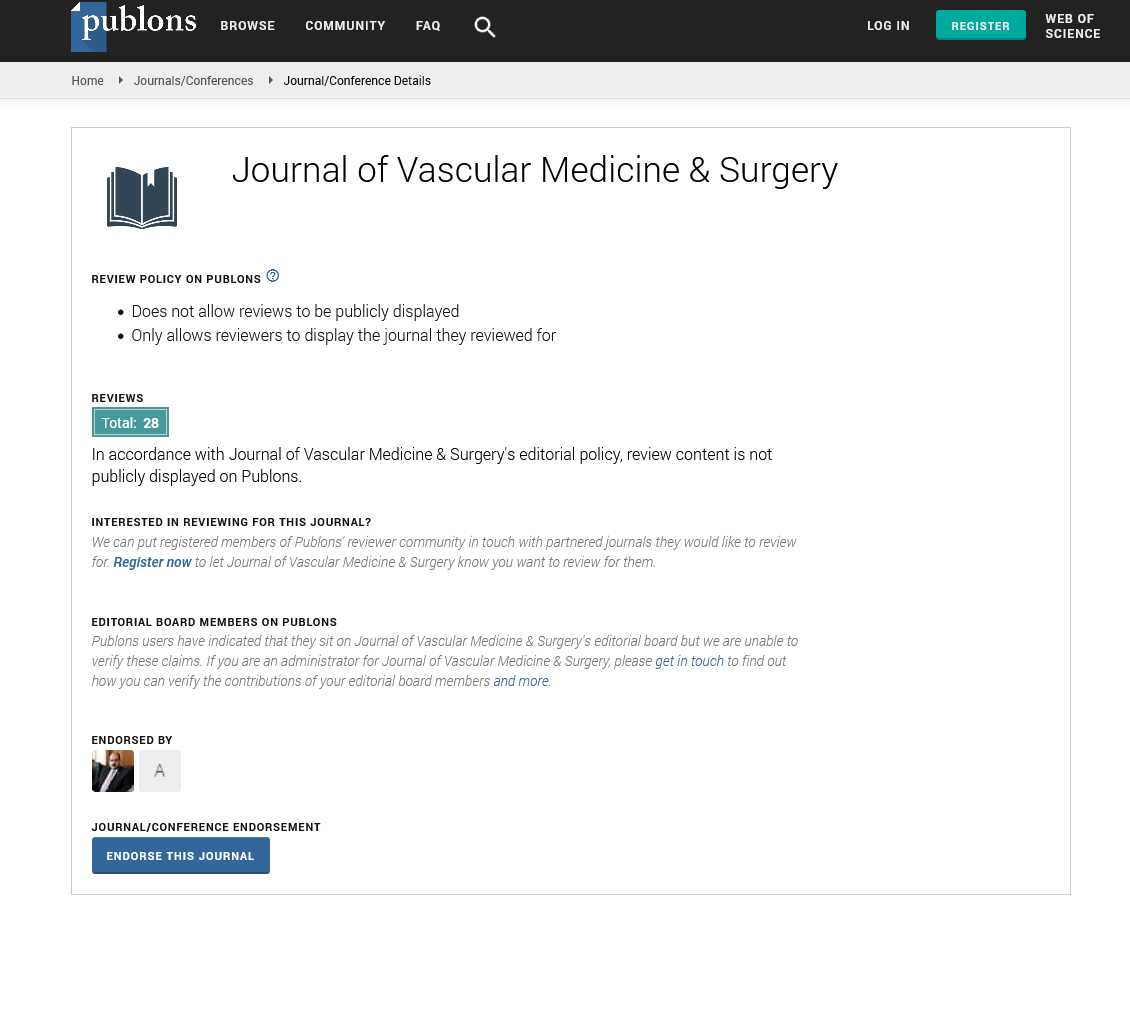Indexed In
- Open J Gate
- Academic Keys
- RefSeek
- Hamdard University
- EBSCO A-Z
- OCLC- WorldCat
- Publons
- Euro Pub
- Google Scholar
- SHERPA ROMEO
Useful Links
Share This Page
Journal Flyer

Open Access Journals
- Agri and Aquaculture
- Biochemistry
- Bioinformatics & Systems Biology
- Business & Management
- Chemistry
- Clinical Sciences
- Engineering
- Food & Nutrition
- General Science
- Genetics & Molecular Biology
- Immunology & Microbiology
- Medical Sciences
- Neuroscience & Psychology
- Nursing & Health Care
- Pharmaceutical Sciences
Commentary Article - (2024) Volume 0, Issue 0
Identifying the Causes, Risk Factors, and Symptoms for Peripheral Vascular Disease is Essential for Reducing the Condition and Increasing Quality of Life
Camilla Maria*Received: 26-May-2024, Manuscript No. JVMS-24-26240; Editor assigned: 28-May-2024, Pre QC No. JVMS-24-26240 (PQ); Reviewed: 12-Jun-2024, QC No. JVMS-24-26240; Revised: 19-Jun-2024, Manuscript No. JVMS-24-26240 (R); Published: 28-Jun-2024, DOI: 10.35248/2329-6925.24.S22.548
Description
Peripheral Vascular Disease (PVD), also known as Peripheral Artery Disease (PAD), is a common cardiovascular disorder in which limited arteries reduce blood flow to the limbs. PVD typically affects the arteries in the legs, though it can also impact other blood vessels. This condition can lead to significant discomfort and complications, including an increased risk of heart attack and stroke.
Peripheral vascular disease refers to disorders of the blood vessels outside the heart and brain. It is primarily caused by the accumulation of fatty deposits (plaques) in the arteries, leading to atherosclerosis. This disorder develops the arteries, reducing blood flow and potentially producing a number of symptoms and implications.
Causes and risk factors
The development of PVD is influenced by several risk factors, which are similar to those for other cardiovascular diseases. Important causes and risk factors include:
Atherosclerosis: The primary cause of PVD is atherosclerosis, a condition characterized by the accumulation of plaques in the arterial walls. These plaques are composed of cholesterol, fats, calcium, and other substances. When they accumulate, the arteries reduce and become harder and reducing blood flow.
Smoking: Smoking is a significant risk factor for peripheral vascular disease. The chemicals in tobacco smoke damage the blood vessels and increase the formation of plaques, increasing the risk of arterial narrowing and blockage.
Diabetes: Diabetes, severely controlled blood sugar levels, can damage blood vessels and nerves, increasing the risk of PVD. Diabetic patients are at a higher risk of developing severe and widespread arterial disease.
Hypertension: High blood pressure produces more pressure on the artery walls, causing damage and increasing the progression of atherosclerosis. Managing blood pressure is essential for reducing the risk of PVD.
Obesity: Excess body weight, especially abdominal obesity, is associated with an increased risk of PVD. Obesity frequently exists with other risk factors such as hypertension, diabetes, and high cholesterol.
Sedentary lifestyle: A lack of physical activity can contribute to the development of PVD by increasing obesity, hypertension, and unhealthy cholesterol levels. Regular exercise is important for maintaining healthy blood vessels.
Family history: A family history of PVD or cardiovascular disease can increase an individual's risk of developing the condition. Genetic factors can influence cholesterol metabolism, blood pressure regulation, and other processes related to arterial health.
Symptoms of peripheral vascular disease
The symptoms of peripheral vascular disease vary depending on the severity and region of the arterial narrowing. Common symptoms include:
Claudication: Intermittent claudication is a characteristic symptom of PVD. It involves pain, discomfort, or fatigue in the leg muscles, typically occurring during walking or exercise and relaxation provides pain relief. The condition is caused by reduced blood flow to the muscles during physical activity.
Numbness or weakness: Reduced blood flow to the limbs can cause numbness, weakness, or a heavy feeling in the legs or arms. These symptoms can interfere with daily activities and mobility.
Poor wound healing: Reduced blood flow to the limbs can impair wound healing, leading to non-healing sores or ulcers, particularly on the feet and toes. This can increase the risk of infection and other complications.
Hair loss and shiny skin: In advanced stages of PVD, the skin on the affected limb may become shiny, and hair loss may occur due to poor blood supply to the hair follicles.
Citation: Maria C (2024) Identifying the Causes, Risk Factors, and Symptoms for Peripheral Vascular Disease is Essential for Reducing the Condition and Increasing Quality of Life. J Vasc Surg. S22:548.
Copyright: © 2024 Maria C. This is an open access article distributed under the terms of the Creative Commons Attribution License, which permits unrestricted use, distribution, and reproduction in any medium, provided the original author and source are credited.

